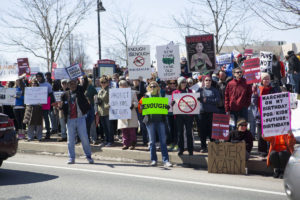
By Katherine Coble || News Editor
The streets of cities from Washington, D.C. to Philadelphia to Tokyo were crammed on Saturday afternoon as students, teachers, and concerned citizens participated in the March for Our Lives. The March was organized following the murder of seventeen people at Marjory Stoneman Douglas High School in Parkland, Florida on February 14, 2018 and called for increased gun control measures. The Parkland shooting is the fourth deadliest of its kind in American history following Virginia Tech (2007), Sandy Hook (2012), and the University of Texas at Austin (1966) and comes in the wake of other mass shootings from the past twenty months including the Las Vegas shooting (2017), Pulse nightclub attack (2016), and Sutherland Springs church shooting (2017). Stoneman Douglas students have been advocating for gun control legislation since the day of the shooting and many media outlets have pointed to the shooting as a catalyst for political enthusiasm in a way that has not occurred following other similar attacks.
The largest march of the afternoon was in Washington, D.C. where activists – primarily students – organized and spoke about their desire to end gun violence through gun control measures. Celebrities such as Ariana Grande and Miley Cyrus performed at the event. Crowd science researchers estimated the attendance in D.C. to be 180,000 people. There were also more than 800 “sister” marches spanning from small southern towns to major international cities. An estimated 5,000 people attended the march in Lancaster, which began at the Barnstormers Stadium and ended at Binns Park downtown. The march in Philadelphia was also well-attended with roughly 15,000 participants marching downtown.
F&M students participated in all three of the aforementioned events. The Diplomatic Congress sponsored a bus to Washington, D.C. while the College Democrats sent a smaller contingent to the march in Philadelphia. Mackenzie Blackwell ‘21, a government major from Michigan, was involved in the organizing of the Philadelphia march and introduced several speakers over the course of the event. The march in Lancaster was organized in part by Elizabeth Fulham ‘20, a history major from Massachusetts. Fulham serves as the political affairs director for the F&M College Democrats and said that watching the crowd flood the streets of Lancaster “felt like all the work I put in had paid off, and I think it’s an image that will stay with me for a long time.” Several F&M students also protested outside of the Gun Gallery, a gun shop recently opened less than half a mile from campus. Whether they travelled one mile or one hundred, F&M students from all walks of life made their voices heard.
Although the marches were hailed by participants as the beginning of a new political movement, political analysts question whether any long-term change will arise from the protests. Hours before citizens took to the streets, President Trump signed a spending bill that took no new steps on gun control as suggested by protestors. The legislation was seen by many as the last opportunity for Congress to impose new regulations on guns before the November midterm elections. However, March for Our Lives organizers do not appear fazed by this inaction.
“The mass shooting generation is nearing voting age,” John Feinblatt said in an interview with the New York Times. Feinblatt is the president of Everytown for Gun Safety, a national organization in favor of gun control legislation. Although young people have historically had the lowest voter turnout numbers of any age group, organizers from the March for Our Lives hope that they will show up to vote in the 2018 midterm elections and hold their officials accountable for their actions (or lack thereof) in Congress. Only time will tell the short- and long-term impact of this March and its young participants.
Sophomore Katherine Coble is the news editor. Her email is kcoble@fandm.edu.